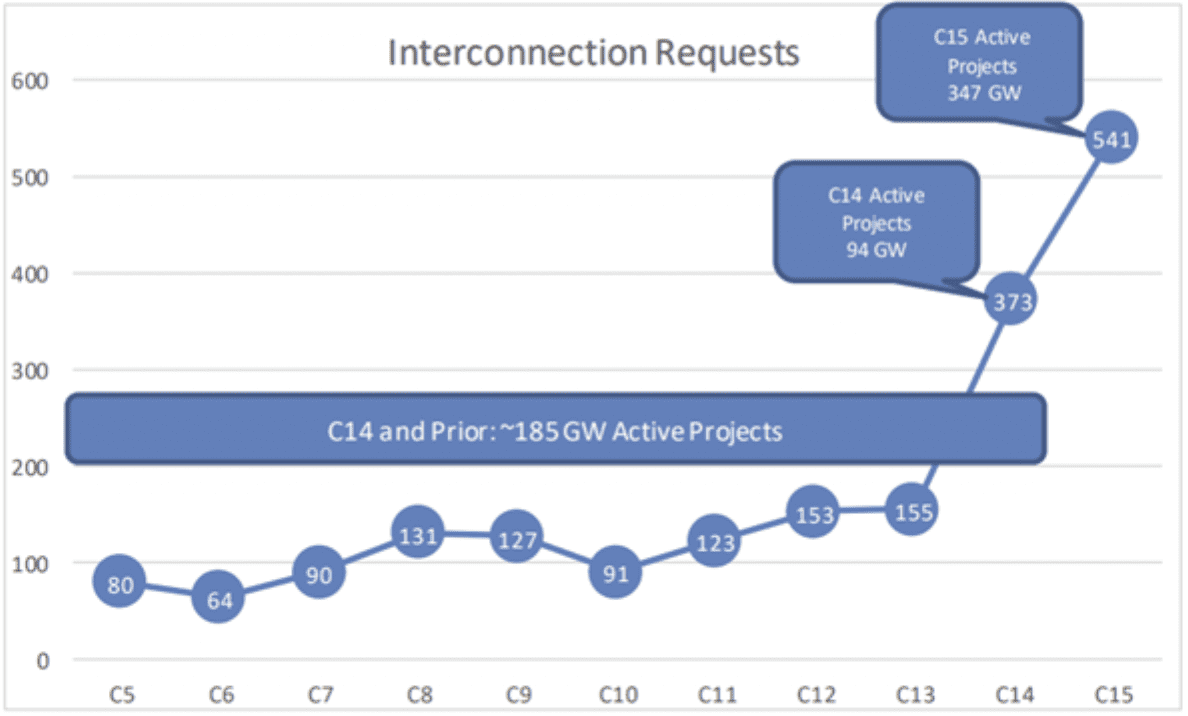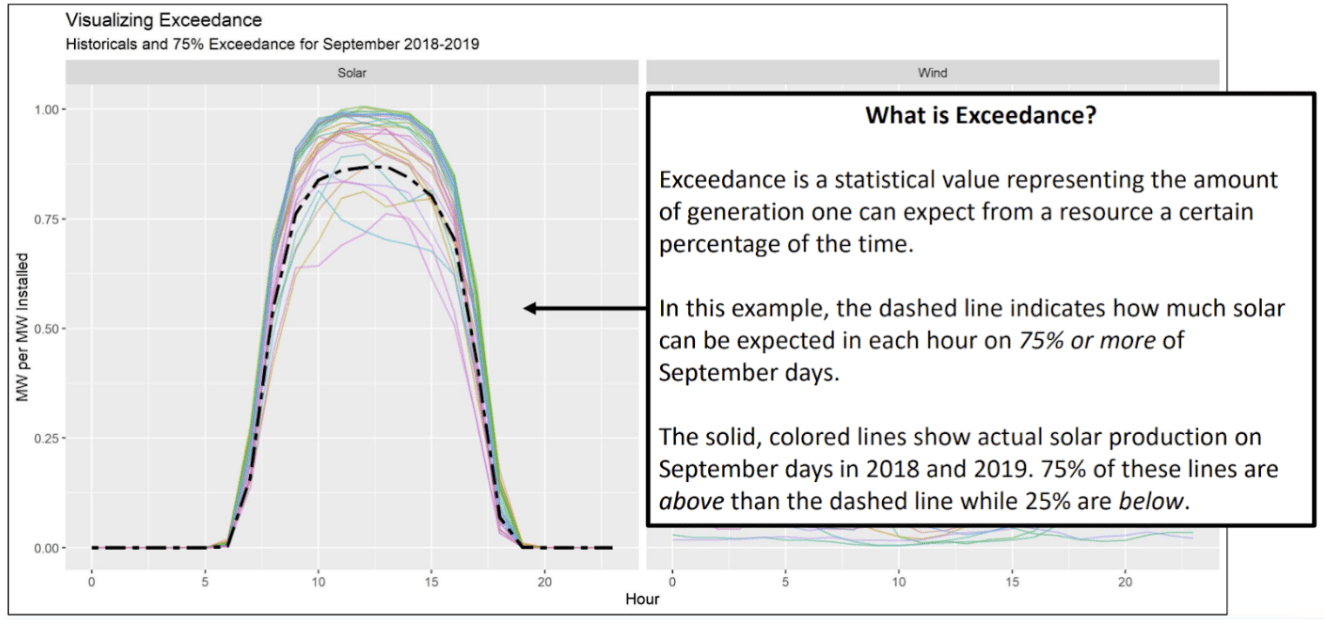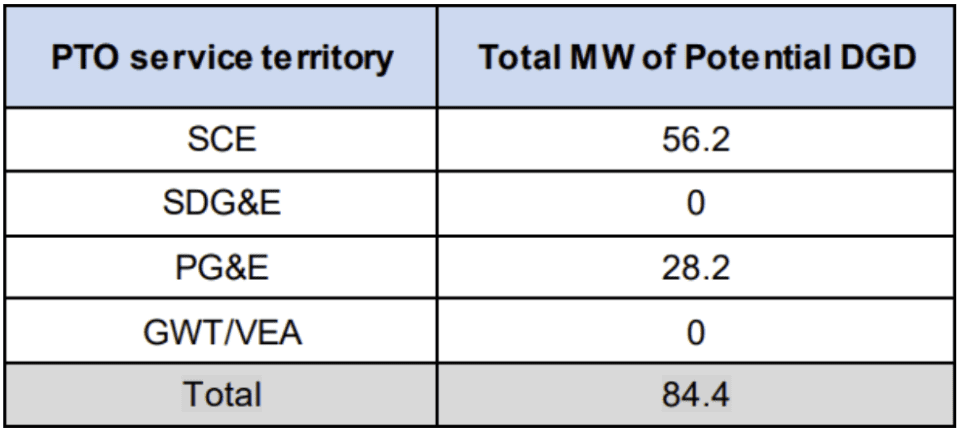
Creating a Pathway for Front-of-Meter Distributed Resource Adequacy to Fix California’s Stunted Capacity Market
This blog post advocates for a streamlined pathway that enables front-of-meter, distribution-connected resources to qualify for Local Resource Adequacy (RA) contracts.
Creating a Pathway for Front-of-Meter Distributed Resource Adequacy to Fix California’s Stunted Capacity Market
Given resource shortfalls and high RA contract prices, California needs a pathway that enables all resource configurations to receive value for providing capacity and helping sustain the grid. The missing piece is a streamlined pathway that enables front-of-meter, distribution-connected resources to qualify for Local Resource Adequacy (RA) contracts.
California has an Resource Adequacy (RA) problem. The mechanisms that make up RA and the market itself are anything but simple, but if there were a single blanket statement that encapsulates the situation, that would be it. For one, RA is currently in short supply, especially for Community Choice Aggregators, a condition that may continue to persist for the next few years, at the very least. Even with new resources connecting to the grid, there is an expected RA shortfall of up to 1,200 MW in 2025 and 3,000 MW in 2026. As a result, prices are high across the board, with load serving entities particularly struggling to find Local RA contracts due to the requirement that the contracted resource must be located in the same local reliability area as the load serving entity. The need for local clean energy deployed quickly – all hallmarks of distributed generation – is a clear indicator that distributed generation must be part of the solution.
Historical Market Benchmark Price for RA in California
|
|
2023 ($/kW-month) | 2024 ($/kW-month) | 2025 ($/kW-month) |
|
Local RA |
$8.60 |
$12.31 |
$11.92 |
|
Flex RA |
$7.82 |
$12.76 |
$16.97 |
| System RA | $14.37 | $26.26 |
$40.31 |
Estimated average prices for each type of RA. Values are based only on RA-only contracts signed in recent years for delivery in the benchmark year. Actual RA contract prices are often significantly higher. The CPUC noted 82 instances of RA contracts signed in 2023 and 2024 that exceeded $100/kW-month.
The short supply of RA and high contact prices are leading to unusual financial arrangements, such as load serving entities swapping RA contracts – system RA for Local RA – at extremely high prices to meet regulatory requirements. Moreover, contracts for resources able to provide RA in the summer months are in especially high demand; as a result, prices can exceed five times the price of an average contract during the rest of the year.
Lastly, adding further complication, the CPUC is implementing a new slice-of-day methodology that requires each load serving entity to ensure sufficient capacity is available in every hour of the day rather than a monthly peak load basis – a change that will only further strain the already scarce resource supply.
High prices and persistent resource shortages both point to a market in desperate need of reform. A changing market and evolving conditions are natural as demand for dispatchable energy in the state increases. However, the biggest challenge lies in the inefficient study pathways a project must complete before signing an RA contract, which are preventing projects from being deemed fully deliverable within the required timeframe. There are currently three pathways a resource can take to receive RA value. I’ll explain each here briefly, with further details provided below to keep the focus on the main message of this article – the need for a streamlined pathway for front-of-meter, distribution connected resources to receive RA.
Links to Detailed Background Information:
- Deliverability
- Types of RA: Local RA, Flex RA, and System RA
- Slice of day framework
- Existing RA Pathways
- The CAISO queue
- The CEC’s BTM Load Modifier Status
- The DGD Study
The most common pathway for front-of-meter (FOM) resources – and by far the slowest – is going through the CAISO interconnection queue to be studied for deliverability. Deliverability, the process of ensuring that the transmission grid has adequate capacity for a resource’s dispatch in the event of a grid emergency, is a prerequisite for receiving compensation for RA. As each subsequent CAISO queue grows to massive proportions and takes an increasing amount of time (3+ years), it is becoming infeasible for many projects – especially small distributed projects – to go through this process. FERC recently approved the postponement of Cluster 15 and the suspension of the schedule for Cluster 16 to ensure that CAISO can complete Clusters 14 and 15, raising questions about the predictability of CAISO Cluster scheduling moving forward.

CAISO Interconnection Request by Cluster and Number of Active Projects
For behind-the-meter (BTM) projects, the CEC has a load modification program that allows a load serving entity to reduce its RA obligation based on the load reduction provided by a generation+storage project during peak periods. This option provides RA value to the load serving entity, without requiring the project to traverse the CAISO queue, making it by far the most streamlined and efficient pathway.
Lastly, CAISO completes a distributed generation deliverability (DGD) study after transmission-connected projects have been studied, to allocate any remaining deliverable capacity to FOM distribution projects. While the study is conducted annually, the pathway is wholly ineffective due to the miniscule amount of capacity allocated and can be disregarded for now. The consequence of having very little capacity available for distribution-interconnected projects is that FOM projects must choose between waiting to be studied in the slow CAISO queue or forgoing RA value altogether – a difficult decision to make.
One of the central value propositions of a FOM project is the ability to be deployed quickly – , an important advantage given the critical need for RA in the short term. Languishing in the CAISO interconnection queue while waiting for a deliverability award undermines the competitive advantage of distributed energy resources (DER) over bulk resources. Moreover, there are many ways a distribution-connected FOM resource can create value: avoiding reliance on the transmission grid, increasing hosting capacity on a local feeder, providing grid services, avoiding future transmission upgrades, deferring distribution upgrades, etc… Unfortunately, these value streams are not always compensated, and RA is a critical part of the value stack. Implementing a streamlined pathway that enables FOM projects to provide RA would significantly increase the number of project deployments.
The key to RA is the deliverability study: can energy be delivered via the transmission grid when the grid is constrained and congested? Connected near the loads they serve, FOM distribution-connected resources offer a more efficient alternative to meet local capacity needs by minimizing the amount of transmission and distribution infrastructure needed for energy to reach the end user. Many FOM projects never export to the transmission grid. For example, the vast majority of the energy from a FOM rooftop deployment at a large load facility will serve on-site demand, while the remainder will be imported by neighboring facilities on the same feeder. As a result, projects like this avoid the major transmission network and reliability upgrades that bulk projects often require. It is therefore worth discussing whether FOM projects that never utilize the transmission grid could avoid a CAISO deliverability study altogether – or whether a streamlined “distribution” deliverability study could be implemented.
Precedent exists for studying distribution deliverability and the ability of DER to provide grid services. In New York, FOM DER are evaluated for voltage support, grid hosting capacity, and local reliability impacts – rather than transmission deliverability – by local utilities as part of the Distributed System Platform (DSP) and Non-Wires Alternatives (NWA) programs. Hawaiian Electric Company (HECO) also has grid services programs that do not require transmission deliverability. In other countries, such as the United Kingdom (UK Power Networks) and Australia’s Dynamic Operating Envelopes, the flexibility that DER provide can be solicited as capacity. Each example demonstrates that California has opportunities to study, and ways to compensate, FOM DER for providing capacity and grid services.
Another aspect of developing a pathway for FOM projects on the distribution grid to receive RA must include improving FOM interconnection by reforming the utilities’ Wholesale Distribution Access Tariffs (WDAT). The myriad of learnings developed by the CPUC from streamlining Rule 21 interconnections over the last 15 years have unfortunately never been fully transferred to the WDAT. As a result, the WDAT is a far more difficult process to navigate. Connecting a 1 MW FOM project via the WDAT takes twice as long and costs eight times as much as connecting a 1 MW project BTM at the exact same site. A large part of the higher cost and longer study times has to do with uncertainty that a developer faces when submitting an application, and the ambiguity surrounding some of the interconnection procedures. For example, some of the utilities have begun consistently failing projects on the Electrical Independence Test – which is intended to determine whether a distribution project has any impact on the transmission grid (either that of the host utility or another transmission owner) – without providing any clear reason or recourse. Without clarity on how a project can pass the Electrical Independence Test, opportunities to deploy FOM DER may continue to be severely limited. Likewise, long delays before reaching the point of budgetary certainty also increases developer uncertainty. As a result, an integral aspect of developing a pathway for FOM DER to receive RA value and strengthening the market segment is to streamline FOM interconnection by reforming the utility WDAT.
Creating a new pathway for distributed FOM projects to receive Local RA contracts would allow the state to be far more nimble in meeting its capacity needs. Refining interconnection processes and recognizing the highly localized capacity value of these resources are both critical aspects of the solution. Doing so will accelerate deployments, reduce RA costs, and enhance grid resilience – all while supporting decarbonization and community energy solutions. Deploying clean local energy is the best way for policymakers to synergistically meet multiple policy goals, providing the greatest value to the ratepayers! In addition to any other RA-related reforms that may (and need to) occur in any of the three existing pathways, ensuring that there is a dedicated pathway for FOM DER should be a priority.
Detailed Background Information:
1. Deliverability
Deliverability is awarded by CAISO to resources that are capable of delivering energy to an end user in conditions where the transmission grid is strained or congested. The study considers the summer peak months and transmission emergency contingencies, testing whether the full amount of available capacity can be deployed in each reliability area with remaining energy exported to another balancing authority if needed. CAISO runs two scenarios, “one is the highest system need (HSN) scenario and the other is known as the secondary system need (SSN) under higher gross load conditions when solar is dropping off.” The test follows three broad steps:
- The ISO builds the initial power flow base case, dispatching all existing generation, and new generation to balance loads and resources.
- The ISO performs a generation sensitivity analysis to identify potentially limited generation pockets. At the most granular level, the sensitivity analysis identifies the exact generation facilities that have the highest flow impact on a particular transmission facility with all other facilities in-service and during forced outages of other facilities.
- For each potentially limiting generation pocket identified in step 2, the ISO increases a subset of the generation with the highest flow impact on that facility to assess the potential for it to be overloaded under stressed system conditions.
Based on the study results, a resource may be awarded an amount of Net Qualifying Capacity, delineated as Full Delivery Capacity Service, Partial Delivery Capacity Service, or Energy Only status (no deliverability). CAISO’s initial on-peak deliverability study was developed in 2004, though it has been modified since then, including significant modifications in 2019-2020 and modified assumptions for energy storage adopted in 2022. The study is run at the end of the CAISO cluster study process. Once deliverability has been awarded, a project may seek to sign an RA contract with a load serving entity.
2. Types of RA: Local RA, Flex RA, and System RA
a. Local RA
A Local RA resource must be able to discharge when called upon for 4 consecutive hours if it has received full capacity deliverability status. The resource must be within the same local reliability area as the contracting load serving entity. There are 10 local reliability areas – Humboldt, North Coast/North Bay, Sierra, Stockton, Greater Bay, Greater Fresno, Kern, La Basin, Big Creek/Ventura, and San Diego/Imperial Valley. Local capacity requirements are calculated in an annual CAISO study using a 1-in-10 weather year and an N-1-1 contingency (which is a scenario where the grid is designed to withstand the loss of two critical components, specifically, a generator or transmission line, and then another critical component). To comply with a Local RA requirement, from July to December, a load serving entity must demonstrate procurement of their revised Local RA obligation (due to load modification or migration) 45 days in advance of the contract delivery month. The revised requirement includes any reduced RA obligations due to BTM load modifiers (determined using the CEC’s Load Modification pathway).
In recent years, load serving entities have struggled to meet Local RA obligations due to the requirement that the contracted resource must be within the same local reliability area as the load serving entity. The scarcity has resulted in volatility and high prices for Local RA contracts, especially as compliance with the slice of day methodology has become a priority. CCAs in particular have struggled to find affordable Local RA contracts amidst reliability/network transmission constraints, high interconnection costs, long interconnection timelines, gas power plant retirements (especially in Southern California), the transition to the slice of day framework, and slow pathways for receiving deliverability.
b. Flex RA
Flex RA is designed to help match supply to the changing demand for energy throughout the day. Often called the duck curve, the shape is created by the rapid increase in demand every day from 4-9 p.m. as residents return home from work. (See the Clean Coalition’s Flattening California’s Duck Curve with Local Solar article for more information). Flex RA resources must meet the requirements for both System RA and Local RA. Flex RA must also offer bids in energy markets and be scheduled for dispatch by CAISO, unlike other RA, which can be self scheduled. Self scheduled resources export at a static level at the market price, promoting grid reliability without participating in market price setting. An annual CAISO study that looks at the largest threehour ramp for each month needed to run the system reliably determines load serving entity obligations for Flex RA procurement. A load serving entity must demonstrate procurement of 100% its monthly Flexible RA obligation (45 days in advance of the procurement month).
c. System RA
System RA resources must be able to discharge to meet a need anywhere on the transmission system. Each load serving entity’s System RA obligation is derived from a CEC-adjusted forecast plus the planning reserve margin (PRM) of 17%. System RA resources have a must-offer-obligation in the event of grid emergencies and are able to participate in markets on a daily basis, via bidding or self-showing. As with other RA contracts, System RA resources participate in CAISO markets and also receive a payment for capacity (e.g., the ability to provide deliverable energy if needed, even if the resource is not actually called upon). Each load serving entity must demonstrate procurement of 100% of its monthly System RA obligation 45 days in advance of the procurement month.
3. Slice of day framework
Previously, to meet its RA obligation, a load serving entity would need to secure sufficient capacity based on monthly peak demand within its service territory plus an additional planning reserve margin. In passing the slice of day methodology, the CPUC acknowledged that while planning for the peak may align with the grid’s most stressed hour, it leaves other periods underserved. Under the new system, a load serving entity must have sufficient RA contracts to meet the peak demand in each hour of the worst load day. The planning reserve margin requirement has also been increased from 15% to 17%, adding pressure to procure even more RA.
The slice of day framework has also changed the way resources are counted, transitioning away from an Effective Load Carrying Capacity metric to the use of Exceedance Values. An Exceedance Value is a statistical calculation of the expected availability of a resource during peak periods within a certain timeframe based on historical data.
 Image from a September 2021 presentation by NP Energy to the CPUC.
Image from a September 2021 presentation by NP Energy to the CPUC.
Use of Exceedance Values provide a more accurate assessment of resource production throughout the day, which is important as the percentage of renewables on the grid continues to increase. Since the slice of day framework shifts away from using a monthly peak to hourly slices, exceedance values are calculated in four-hour chunks.
4. Existing RA Pathways
a. The CAISO queue
Most projects that receive RA contracts are interconnected and receive a deliverability award by progressing through the CAISO queue. Due to complexity and increasing numbers of application submissions, each cluster is taking longer to complete than the last. At this point, the schedule for the next two Clusters has not been finalized, creating uncertainty for developers. The longstanding interconnection procedure, ending with Cluster 14, had been to conduct a Phase I and Phase II study, each of which takes around 12 months to complete (deliverability would be assessed as part of the Phase II study in this model). However, in the last few years, CAISO has received approval for a reformed process that is far more integrated, which will be tested with Cluster 15. Under the new process, the CAISO will conduct a Deliverability Assessment in parallel with a Cluster Study and the results of both will be released at the same time, attempting to provide applicants with an earlier point of certainty on whether deliverability will be awarded and the likelihood of a successful interconnection. Following the release of the Cluster Study, a Reassessment that incorporates any changes will be conducted as well as a Facilities Study prior to an applicant finalizing a deliverability allocation. From the opening of the Cluster to the point when generator interconnection agreements are executed, the total timeline is expected to be at least three years. And with so many applications already submitted for Cluster 15, Cluster 16 may be the only real option for projects seeking deliverability in the near future. If Cluster 16 opens in 2027, it will not be completed until 2029 or 2030. Smaller projects being planned not just can’t afford to wait that long before beginning operations.
If a project is not awarded deliverability they may seek an allocation in a future Cluster Study, hope that the next Transmission Plan opens up deliverability, or consider the distributed generation deliverability (DGD) results if connected to the distribution grid.
FERC recently approved a new CAISO proposal to add prioritization criteria in the interconnection queue and designate areas with less than 50 MW of capacity left as “merchant zones” where project developers pay for any upgrades. When Clusters 15 and 16 begin, this change may impact how deliverability is awarded.
b. The CEC’s BTM Load Modifier Status
The CEC is responsible for creating the load forecast that determines the RA obligations for each load serving entity. Before a load serving entity submits a final RA compliance plan for the calendar year, the CEC makes an amendment, reducing RA requirements based on the total amount of load modification and load migration. A BTM generation+storage project operated to reduce load during the 4-9 pm peak will be designated a load modifier, benefitting the load serving entity in the form of avoided RA. There is no official compensation for being designated as a load modifier, so the DER owner may have to work with the load serving entity to receive a financial benefit for the value created. Demand response and managed EV charging are also other BTM use cases that may be designated as load modifiers.
c. The DGD Study
The DGD study is performed within the broader deliverability assessment once the final interconnection studies are complete. The study examines local grid constraints and whether the project can deliver capacity without requiring significant transmission upgrades. While the study is completed annually, the MW of deliverability allocated is never enough to support more than a handful of projects. CAISO has allocated 0 MW to San Diego Gas & Electric since 2021 and 0 MW to PG&E in 2023 and 2024. The table below contains the 2025 DGD allocations. Notice that SDG&E continues to receive an allocation of 0 MW, despite clear desire from load serving entities to procure additional Local RA to avoid RA penalties.

2025 CAISO DGD Allocation
One critical shortcoming of the DGD study process is that it only considers nodes where distributed generation has been allocated in the most recent Transmission Plan renewable portfolio. The results of the DGD study therefore do not correspond to the true total MW of deliverable generation that can be connected anywhere on a utility’s distribution grid or have any correlation to market demand for using FOM projects on the distribution to meet Local RA requirement. Instead, the DGD study relies on preset locations (nodes) based on a portfolio that consistently underforecasts the need for distributed resources. This process needs to be fixed to be of any value in helping reduce the current RA bottleneck.

